Adams County’s “Clothesline of Quilts”
It began in 2001 when Donna Sue Groves had a dream of someday honoring her mother with a large quilt mural painted on their barn reflecting her mother’s passion, quilting. That one dream has now led to more than the planned 20 quilt squares throughout Adams County and beyond! Donna teamed up with the P.A.C.T. (Planning Adams County’s Tomorrow) and after receiving a grant from the Ohio Arts Council, begin the counties colorful display of historical quilt squares. The idea soon spread across the nation. The Adams County Chamber of Commerce, The Nature Conservancy, Foundation for Appalachian, along with several local businesses, and residences made contributions, some of which, financed and designed their own quilt squares.
Here is a list of the names of the 20 original quilt squares and where they are located
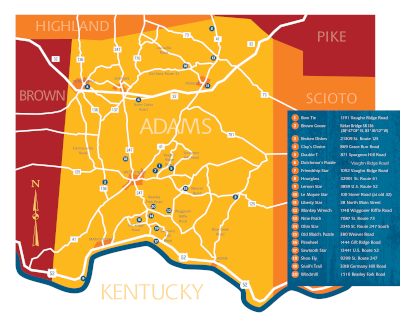
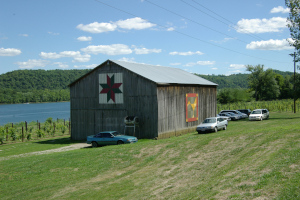
Lemon Star
This pattern, based on nine squares, is similar to the Ohio Star. The star points are extended to the center, whereas the Ohio Star has a square center. Also called Le Moyne Star, it is a variation of the old Variable Star pattern. The Lemon Star is west of Manchester on U.S. 52.
3859 U.S. Route 52
Manchester, OH
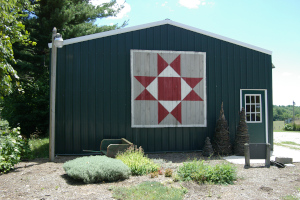
Ohio Star
Ohio Star is based on a very old pattern known as Variable Star. Traditionally, the Ohio Star is made using two colors, but may include three. It has been a favorite since pioneer days in Ohio. Blue and white, or red and white were used many of the earlier versions. After the annexation of Texas to the United States, a greatly enlarged version of this pattern became known Lone Star or Texas Star. These were done in small diamond pieces that made up on large star for the entire quilt. Popular during the 1930’s, they could be purchased in kit form. Located south of West Union on St. Rt. 41 at Lewis Mountain.
2345 St. Rt. 247 South
Manchester, OH
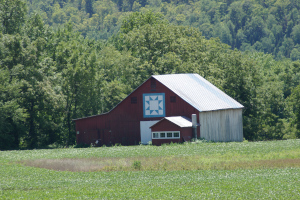
Sawtooth Star
Also called Nameless Star, this pattern is the basis for numerous variations and lends itself to color placement as part of the larger block. It is similar to the Variable Star but has a larger center and smaller points. The large center square was often used for signatures in album quilts.
Located near the village of Rome on U.S. 52.
13441 U.S. Route 52
Rome, OH
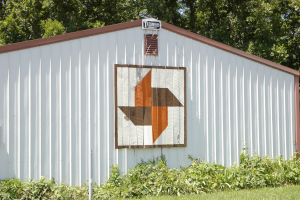
Pinwheel
There are many quilt blocks called “pinwheel.” This one is based on 16 squares. It is simple to construct of squares and triangles. One name for it was Spinning Star. Look at the Friendship Star to see how it is related. The four center squares are changed to triangles and it takes on a very different look. Located on Gift Ridge Road south of West Union.
1444 Gift Ridge Road
Manchester, OH
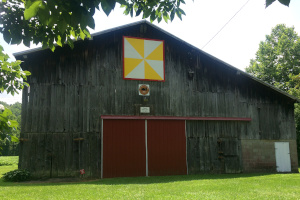
Windmill
Windmill is one of the oldest of the four-patch patterns. Before commercial patterns were sold, this one could easily be made at home. Light and dark triangles are used to achieve the windmill effect. It was often a scrap quilt. Later and more complicated arrangements of color were Water Wheel, Mill Wheel and Water Mill. Modern versions using only three fabrics create one called Broken Dishes. Located on Beasley Fork Road southeast of West Union.
1510 Beasley Fork Road
West Union, OH
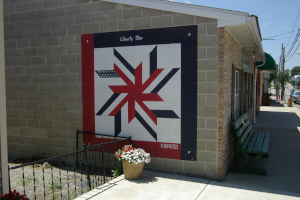
Liberty Star
The pattern for this one was published in the Kansas City Star newspaper in 1932. Directions specified it was to be done in red, white and blue. Other names for it have been Stars of Strips and Tennessee. Located on St. Rt. 41 in downtown Peebles at the White Star Restaurant.
38 North Main Street
Peebles, OH
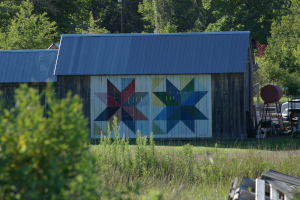
Le Moyne Stars
The brother Le Moyne settled in Louisiana in 1699. The younger brother, Jean Baptiste, founded New Orleans in 1718. By 1768, when he died, much territory had been claimed by France. After the Louisiana Purchase by the United States in 1803, this quilt pattern was named for them. It is based on sixteen squares. Countless variations of the eight-pointed star made their appearance in the early 19th century. These include Pieced Star, the Texas or Lone Star, also called Star of Bethlehem and the Ohio Star. Its popularity is attributed to the ease with which a pattern for it could be made before commercial patterns were available. It is often used as a design element in other patterns. Located west of Peebles on old St. Rt. 32.
100 Storer Road
Peebles, OH
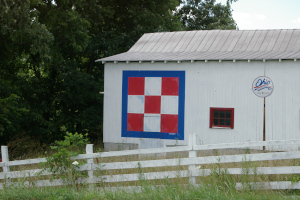
Nine Patch
Along with the four-patch patterns, this is one of the earliest used by pioneer woman. They had to create their own patterns before commercial ones were invented. A very early example from Massachusetts is dated 1808. It has continued as a favorite to the present day. The Fundamental Nine Patch, as it once was called, has been the basis for countless variations. It is often used along with the one patch and four patch to teach beginners. It has always been much used as a utility quilt made from cotton or woolen scraps. This two-color pattern can be found as a building border design or in commercials. Located on St. Rt. 73 west of Locust Grove.
7087 St. Rt. 73
Peebles, OH
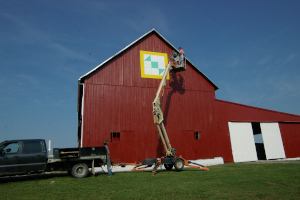
Hourglass
Many different blocks have been named “hourglass,” but this is the earliest one found. It is based on the Nine Patch and has remained popular, possibly because it is so easy to make. A variation is known as Split Nine Patch. The Hourglass is located north of Peebles on St. Rt. 41.
32901 St. Rt. 41
Peebles, OH
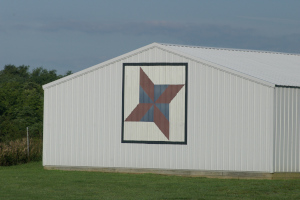
Clay’s Choice
This pattern was published as Ladies Art Company pattern #16 between 1895-97. At first, it was known by several names. In addition to Clay’s Choice, it was called Henry’s Choice and Henry of the West, all in honor of Henry Clay. Later it was called Star of the West. Located just east of Winchester; you’ll pass it traveling in the west bound lane on St. Rt. 32.
869 Grace Run Road
Winchester, OH
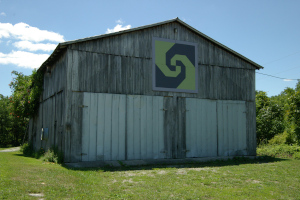
Snail’s Trail
Snail’s Trail – sometimes called Monkey Wrench, and a close relative to Indiana Puzzle, which became very famous in pioneer Indiana – has been done in various sizes. One in the collection of local quilter, the late Nina Maxine Groves, is done in just four squares in the mourning prints of the late 19th century. The interlocking part alone is a very effective statement when done in two strong colors. When done in small squares, it really looks like a puzzle. The pattern is made up of squares, beginning with the largest one and folding in on themselves. Located on Germany Hill Rd off St. Rt. 247 south.
3318 Germany Hill Road
Manchester, OH
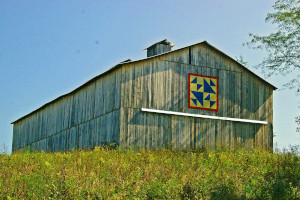
Old Maid’s Puzzle
There are many variations, depending on color placement. Originating in 1895, it remained popular through 1920’s and 30’s. Located on Weaver Road, off St. Rt. 125 east of West Union.
380 Weaver Road
West Union, OH
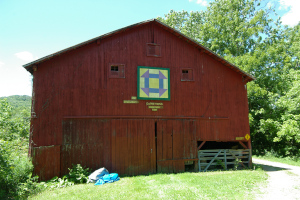
Monkey Wrench
This is a variation based on the Nine Patch. Compare it with Shoo Fly to see how closely they are related and how both are an outgrowth of the Nine Patch. It is known by several names, including Hole-in-the-Barn Door, Puss-in-the-Corner, Lincoln’s Platform and Sherman’s March. The last two name are indicative of its popularity during the Civil War. Churn Das- another close relative- enlarges the corners and squares the center row. Located on Waggoner Riffle Road.
1748 Waggoner Riffle Road
West Union, OH
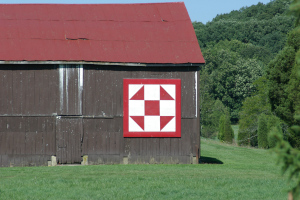
Shoo Fly
Shoo Fly is one of the earliest versions of the Nine Patch. It is older than the once-popular song by the same name and was popular before printed patterns became available. The square corners are cut into triangles, while the other pieces remain square. From this change, it moved on to other variations, such as the Monkey Wrench. Later changes led to Ducks and Ducklings, Hen and Chick, Corn and Beans, and Handy Andy. Notice how all the names are related to a rural lifestyle. Other, more complicated versions are the T blocks and Joseph’s Coat. Located north of West Union on St. Rt. 247
9299 St. Rt. 247
West Union, OH
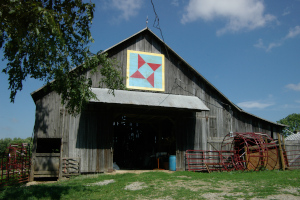
Friendship Star
Its long popularity may be attributed to its simplicity of construction. It takes on a very different look when set up with sashing between the blocks. Also identified as Simplex Star and Lost Goslin’. Located on Vaughn Ridge Rd, east of West Union.
1092 Vaughn Ridge Road
West Union, OH
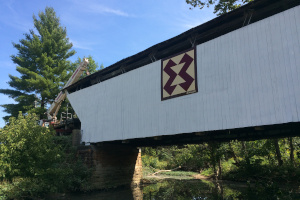
Brown Goose
An old pattern much used for everyday quilts, this was also known as Gray Goose, depending on the calicoes used in making it. It later became known as Double Z or Devil’s Claws. It has not retained its popularity through the years. A family heirloom Brown Goose signed 1895 is owned Niles and Martha Bennett of Manchester, Ohio. An ancestor went to medical college in Philadelphia where he met and married a young woman. Among her possessions was the quilt top with her maiden initials and the date embroidered on it. It came to Adams County with her and remained unquilted until 1998. The brown calicoes of the period from which it was pieced remain as fresh today as when it was made one hundred years ago. Located on the historic Kirker Cover Bridge on St. Rt. 136.
St. Rt. 136 Kirker Covered Bridge
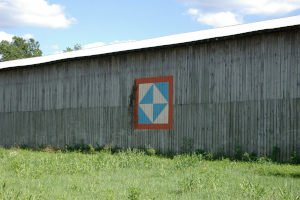
Broken Dishes
Although simple in constructions, this pattern can be used to create complex quilts, many using two or three colors. It was also popular as a scrap quilt. The Kansas Star published it as The Double Square in the 1920’s. From West Union take St. Rt. 125 East.
21309 St. Rt. 125
Blue Creek, OH
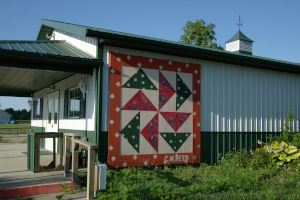
Dutchman’s Puzzle
Many old quilts using this pattern have been found around Staten and Manhattan Islands in New York. This was an area of early Dutch settlement and perhaps the name comes from them. It is based on the windmill pattern. Each of the four squares is divided into six triangles rather than two. The resulting pieces are very small. Perhaps this accounts for its lack of popularity today. Previously located across from Yoder’s Market, the Dutchman’s Puzzle is being relocated to Vaughn Ridge Rd.
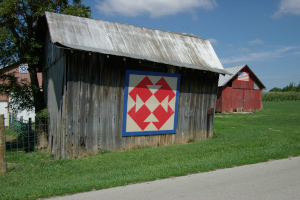
Double T
This pattern was published between 1895–97. Carrie Hall named it Capital T in the 1920’s. It is one of many T block variations. It makes a striking quilt done in two boldly contrasting colors. Located east of West Union on Spurgeon Hill Road.
871 Spurgeon Hill Road
West Union, OH
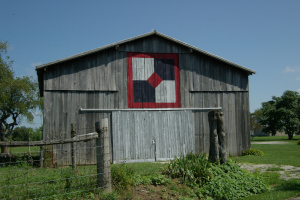
Bow Tie
This pattern is widely used in everyday quilts. An earlier name from 1889 is Necktie. Based on the four-patch piecing, it can vary widely in appearance according to the way it is set up. A horizontal or diagonal setting with sashing gives it a row effect. Without sashing it can be difficult to recognizing it as a Bow Tie. It is still popular today, perhaps because of its simplicity and versatility. This quilt barn can be found east of West Union on Vaughn Ridge Road.
1191 Vaughn Ridge Road
West Union, OH
